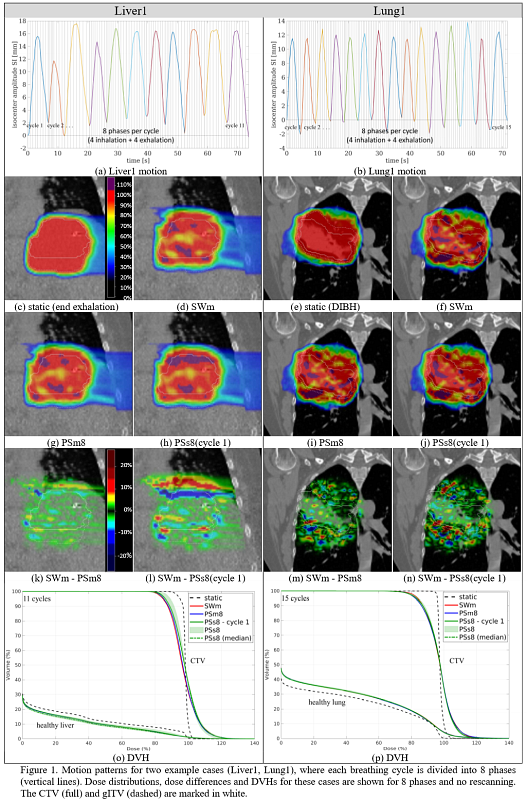Limitations of phase-sorting based pencil beam 4D proton dose calculation under irregular motion
Alisha Duetschler,
Switzerland
MO-0472
Abstract
Limitations of phase-sorting based pencil beam 4D proton dose calculation under irregular motion
Authors: Alisha Duetschler1,2, Jessica Prendi1,3, Sairos Safai1, Damien C Weber1,4,5, Antony J Lomax1,2, Ye Zhang1
1Paul Scherrer Institute, Center for Proton Therapy, Villigen PSI, Switzerland; 2ETH Zurich, Department of Physics, Zurich, Switzerland; 3University of Basel, Department of Physics, Basel, Switzerland; 4University Hospital of Zurich, Department of Radiation Oncology, Zurich, Switzerland; 5University of Bern, Department of Radiation Oncology, Bern, Switzerland
Show Affiliations
Hide Affiliations
Purpose or Objective
4D dose calculation
(4DDC) is an important tool for evaluating pencil beam scanned (PBS) proton treatments for moving tumors. We
investigate the limitations of the conventional phase-sorting (PS) 4DDC based
on a single 4DCT, due to the lack of breathing variability and its rather
coarse temporal resolution.
Material and Methods
Multicycle motions
from two 4DMRIs were used to generate six synthetic 4DCT(MRI)1,2
datasets for three liver and three lung cancer patient CTs, providing irregular
motion scenarios and their associated density variations (11/15 breathing
cycles for liver/lung cases, respectively). Using superior-inferior (SI)
isocenter motions as a surrogate, each breathing cycle was divided into 8 or 10
phases with equal number of phases in in- and exhalation (Fig1; temporal
resolution 0.4-1 s). Based on its time of delivery, each pencil beam of a plan was
then assigned to one motion phase either from a single reference cycle to
simulate PS for different reference 4DCTs (PS
single cycle-PSs) or from the full irregular
motion pattern (PS multicycle-PSm). 4D dose distributions of both scenarios were
compared to dose distributions calculated using the deforming-dose-grid
algorithm, which works at a temporal resolution determined by the time between
the delivery of pencil beams (typically 4-200 ms) (spot wise multicycle-SWm)1. Two-field plans were optimized on the static reference
CT of each dataset using a geometric internal target volume (gITV). 4DDCs were assessed
for delivery scenarios of single scanning
(VS1) and 8-times volumetric rescanning (VS8). The
dosimetric impact of the 4DDC scenarios and number of phases per cycle (8/10)
was studied.
Results
Dose distributions (VS1)
for example liver and lung cases are depicted in Fig1. Pronounced differences between PSs and PSm show the impact of
motion irregularity, as PSs only considers a single reference 4DCT. Fig2 compares the dosimetric indices of the different
4DDC scenarios and the influence of the reference 4DCT selection (boxplots). Depending
on the choice of reference 4DCT, PSs8 can underestimate
motion effects and therefore misestimate D5%-D95% and V95%
by up to -8.9% and +16.9% compared to SWm results. On average, V95%
is overestimated by 2.2% (PSs8) for interplay effect evaluations
(VS1). Moreover, the influence of the
reference 4DCT selection on the dosimetric indices (box
sizes) are comparable for VS1 and VS8 and liver and lung anatomies. However, PS
results for rescanning are more similar to the SWm results (mean difference V95% SWm-PSs8: -0.2%). Furthermore, dosimetric differences due to either the different temporal
resolution for PS and SWm or different numbers of phases (8 or 10) are only marginal.


Conclusion
It is essential to properly consider motion
irregularity when performing 4DDC based dosimetric evaluations for PBS 4D
treatments as conventional PS 4DDC based on a single 4DCT can underestimate
motion effects.
1 Boye et al. Med Phys. 2013
2 Duetschler et al. Radiother Oncol. 2021